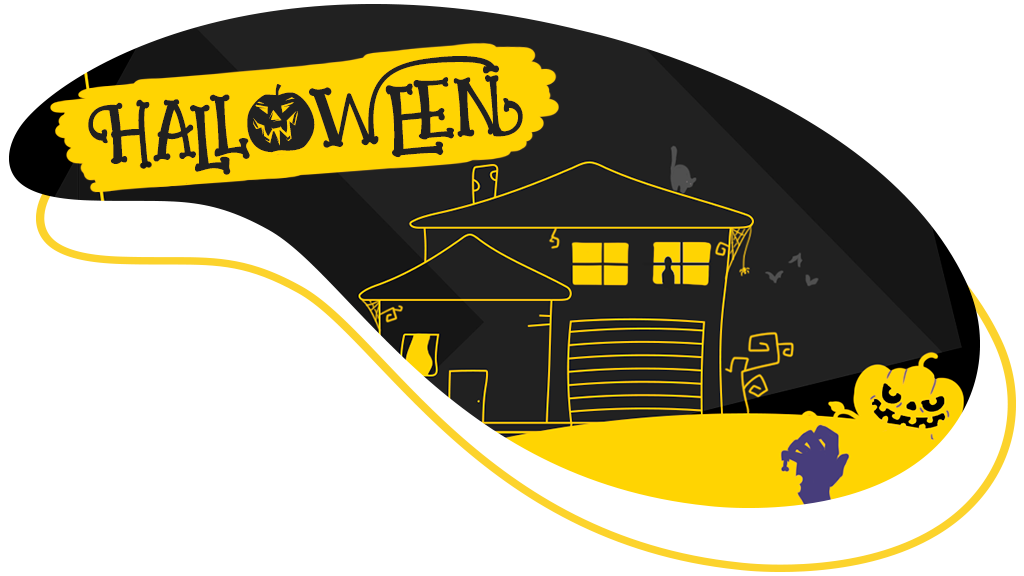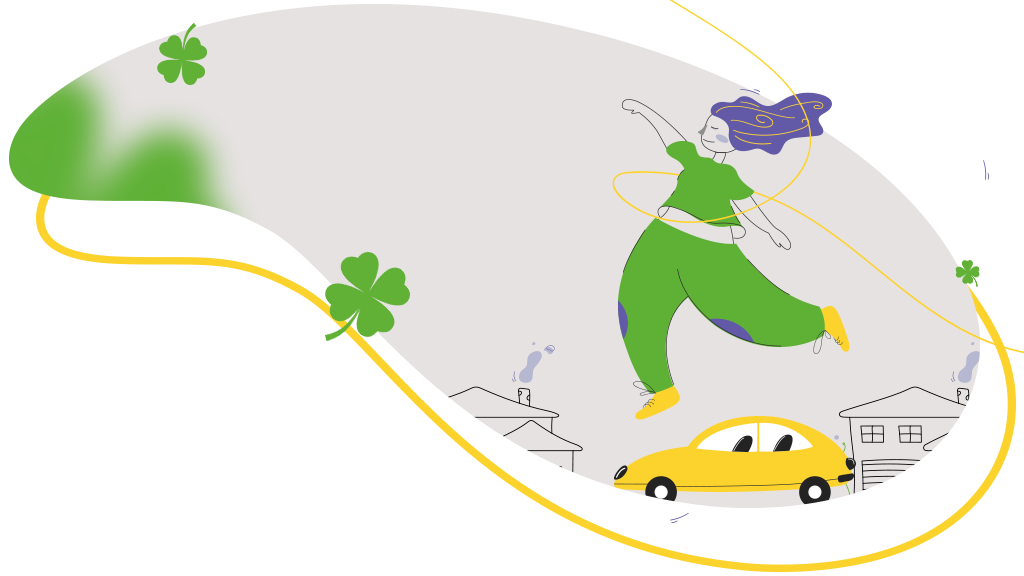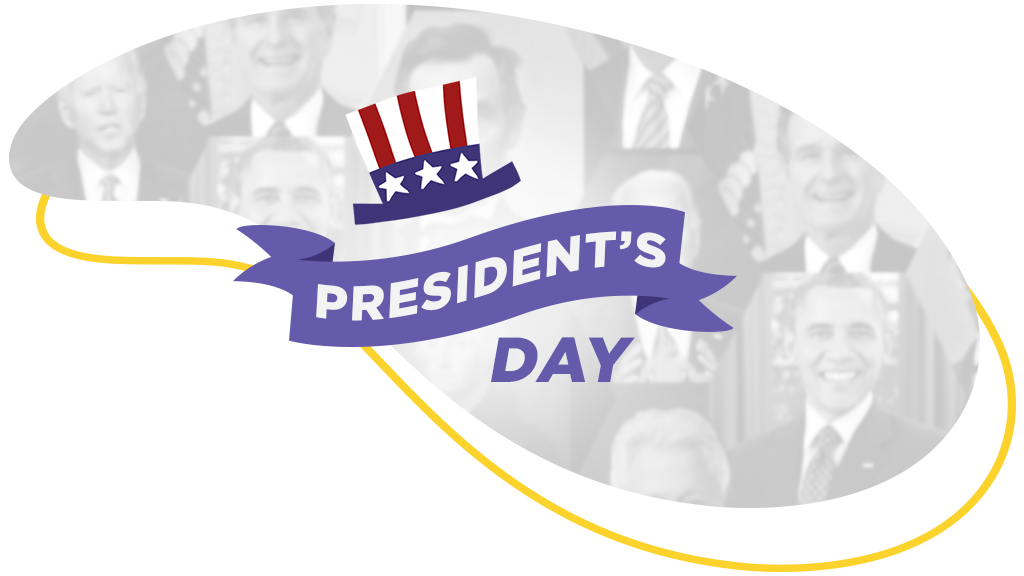Learn More
x




Today is Halloween!!! Despite taking place only on October 31st, this one day affects the entire month of October in the US, surrounding us with skulls, pumpkins, monsters and witches to no end. But do you know the story behind this day? What do the symbols represent? Also, what’s with all the witches?
If you’re looking to make last-minute plans, do not fear (even on Halloween 👻). Just check out our most recent post! There’s even a list of movie recommendations for you to enjoy a Hollywood vibe as your Halloween treat.
First things first, get to know the history behind this tradition. Be warned– it is full of all sorts of curious and frightening details…
Most scholars agree that Halloween is a very old tradition. About 2000 years ago, the Celts, who lived between Ireland, the United Kingdom and northern France, celebrated the beginning of a new year with a festival called Samhain (pronounced sau-ihn), which took place on November 1st.
The day marked the end of summer and harvest and the beginning of the dark, cold winter season, which was a time associated with death. There was a belief that on the night of the turn of the year, October 31st, the veil between the living world and the spiritual world became thinner. That would be the day when the souls of those who died the year before could make the passage to the spirit world. This facilitated communication between the two worlds and even made it possible for ghosts to visit Earth.
They believed that when passing through the land, these souls would make mischief with the living, so in order to protect themselves, they made offerings of their crops and hunted goods. On the same night, however, people were known to also play games, since they could just blame the spirits. They would dress up as monsters and magical creatures to mix with the creatures of the night and eventually take advantage of the goodies offered.
Another Celtic custom was to keep a fire burning to keep the channels of communication open at night and to burn crops and animals as a sacrifice to the spirits and deities.
There are other explanations for the bonfire. Some believe it was a way of paying homage to the Sun god so that they would return after the winter, others that it would be a kind of walkway for their dead loved ones to make the passage without getting lost.
They used the flames of the celebration fires to light the hearths of their homes with the intention of using the sacred fire to protect them through the long, harsh winter.
These bonfires likely led to the origin of bats in the Halloween tradition. The Druids’ Samhain bonfires attracted insects which, in turn, attracted bats towards a tasty meal. In later years, a number of folklore emerged citing bats as harbingers of death or disgrace. In Nova Scotia mythology, a bat settling in a house means that a male family member will die. If he flies off and tries to escape, a woman in the family will die. 😳
From the conquest of Celtic territory by the Roman Empire in AD 43, a period of 400 years of domination began, which inevitably culminated in the fusion of traditions. At Samhain, two autumn festivals were combined: Feralia and the festival of Pomona.
Feralia took place at the end of October in order to honor the dead. The party of Pomona, the goddess of fruits and trees, whose symbol is an apple, may have brought the custom of playing with apples on Halloween.
Various Catholic popes throughout the ages have tried to replace “pagan” holidays like Samhain with holidays that represented their religious practices. In 1000 AD, the Catholic Church made November 2 the Day of the Dead, a day to honor the dead and replace the Celtic date. All Saints Day was set for November 1st.
Contrary to the church, the celebration of Samhain continued to take place the day before, on October 31st. This day was then renamed ALL-HALLOWS-EVE (all = all, hallows = saints, eve = eve, the eve of All Saints’ Day) and would eventually turn into the word HALLOWEEN.
Despite the new religious focus, this time of year continued to be associated with the visit of the dead who roam between the two worlds in England and Ireland, with people handing out food to hungry spirits.
Costumes were used so that people could disguise themselves as spirits and forest beings (Celts believed in fairies, goblins and magical beings) and not be bothered. The practice also allowed “undercover” humans to take the goodies intended for the spirits. Does that ring a bell? (Pun intended)
The first Halloween-like festivities in America emerged predominantly in the southern colonies. In New England, it was frowned upon because of the region’s religious customs and beliefs.
However, as the US is diverse in ethnicity and customs, traditions, festivals and beliefs were mixed and ultimately evolved to become the Halloween we know today.
The first celebrations were called “play parties,” which were public events held for the population to celebrate the harvest, exchange ghost stories, sing dances and even “read” each other’s fortunes.
Until the mid-19th century, autumn festivals were not celebrated nationally, although they were not uncommon. But with the wave of immigrants that came in the middle of the century, among them many Irish who still celebrated Celtic traditions, Halloween was introduced and eventually became popular across the country.
Newcomers brought their own superstitions and customs, such as the jack-o’-lantern, which was carved from turnips, potatoes and beets. Arriving here, due to the abundance of pumpkins in the period, they replaced the vegetable.
Appropriating European customs, the US population began to wear costumes and go from house to house asking for food or money. Trick-or-treat, anyone?
At the end of the century, part of the population struggled to make Halloween a holiday that was more about community and neighbors’ encounters than ghosts, pranks and witchcraft.
Parents were encouraged to remove the scary connotation of the celebrations and throughout its evolution, the date lost its religious and superstitious sense.
Trick-or-treating soared in popularity in the 1950s, during the baby boom. Halloween events were brought into the classroom and homes to better serve the children, who became the main audience.
Trick-or-treating was a relatively inexpensive way for the community to share the celebration, and to avoid pranks being played by offering small treats to neighborhood children.
Today, more than 179 million Americans celebrate the holiday — and spend an estimated $9.1 billion on Halloween each year, according to the National Retail Federation, making it the second largest commercial holiday in the nation after Christmas.
Fun fact: A quarter of all candy sold annually in the US is purchased for Halloween.
Salem, Massachusetts was famous for the witch trials in 1692, when in just three months, 19 innocent people, 14 women and 5 men, were hanged and one man pressed to death. It was a time of hysteria, when the courts believed in the devil, the spectral evidence, and the dangers of teenage girls.
The trials ended when Governor William Phipps dissolved the court after his wife was accused of being a witch. A Superior Court was then formed to replace what was in effect and effectively banned spectral evidence.
The new court released those awaiting trial and pardoned those awaiting execution. The trials were over.
Over the centuries, the city has appropriated history and expanded upon it, creating legends and hair-raising witch stories. The entertainment industry has helped maintain the myths with movies and books on the topic. Today, the city is visited by tourists from all over the world, especially in the month of October.
Despite changing the entire routine of US residents for a whole month, Halloween is not an official holiday. For most commercial establishments, it is a business day like any other.
That said, there are companies that encourage the use of costumes on the day and partake in special activities to celebrate Halloween.
In 2021, however, Halloween falls on a Sunday, so be sure to wear your best costume and enjoy the day! You will have the entire weekend at your disposal to enjoy the spookiest time of the year…
Learn More

June 1st is U.S. Flip a Coin Day, where we celebrate (or at least reflect on) the history and significance of the famous coin flip.

We make it a point at BRZ to explain the meanings of popular US celebrations and holidays for our readers who are immigrants. With the beloved Saint Patrick’s Day, we make no exception.

The third Monday in February has been designated as Presidents' Day. Read more to learn all about the history of this US federal holiday.

We are an insurance company made by people for people. A community that speaks tyour language, with people who care about your future! Here you can find all the protection and care that a home offers. Come and join us!
Get a Quote

Need help? Chat with BRZ!
x